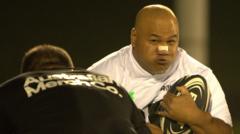The "Run It Championship League," touted as the "world's fiercest new collision sport," is gaining worldwide traction as it draws from its roots in the backyard games of Australia and New Zealand. Two players, racing towards each other at full speed, engage in bare-knuckle one-on-one tackles, creating adrenaline-charged moments that enthrall audiences and gather significant online views.
The founders, Brandon Taua'a and Stephen Hancock, reminisce about their childhoods in Melbourne, where the game originated. Their league has already secured prominent sponsorships and captured the interest of potential investors, eyeing expansion into the UK and US markets. However, the pressing concern among medical professionals is the violent nature of the sport, which has become popular on social media despite warnings against its safety.
Critics argue that while the league promotes a thrilling spectacle, the risks involved cannot be overlooked. The tragic story of Ryan Satterthwaite, who suffered a severe brain injury playing a backyard version of the game, highlights the dangers that accompany such confrontational sports. Advocates for mental health caution that glorifying violence among young men could reinforce toxic masculinity, presenting pain tolerance as a metric of worth.
The league has outlined protocols aimed at minimizing injuries, including comprehensive medical assessments. Yet experts remain skeptical, asserting that no amount of preparation can fully mitigate the risk of concussions and other serious head injuries associated with running full force at an opponent.
Despite the controversies, the league's promoters are undeterred. They believe that what they have created may evolve into a recognized sport akin to MMA or boxing, emphasizing skill alongside physicality. As the league prepares for a major event in Dubai, the future of "Run It" remains at a crossroads, balancing the exhilarating appeal of collision sports against mounting health concerns.




















